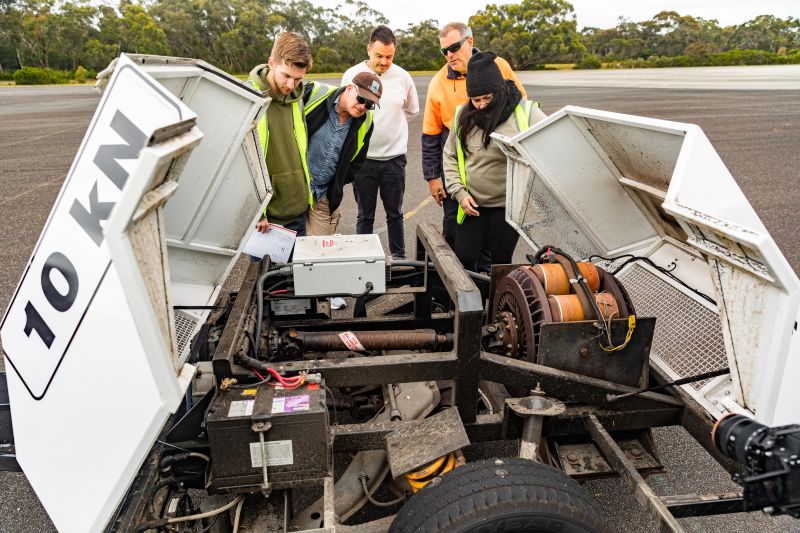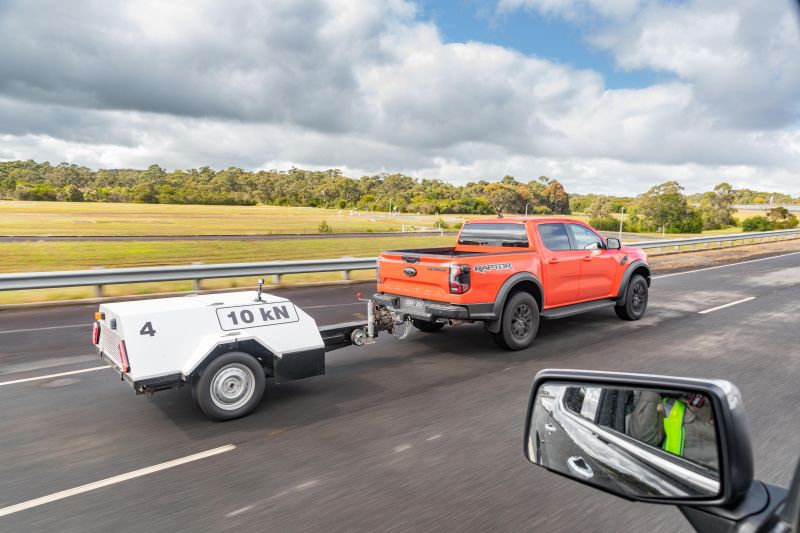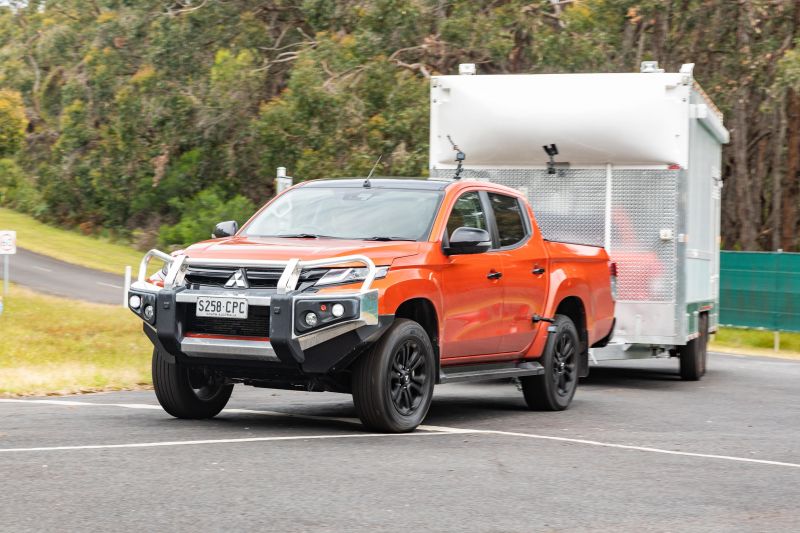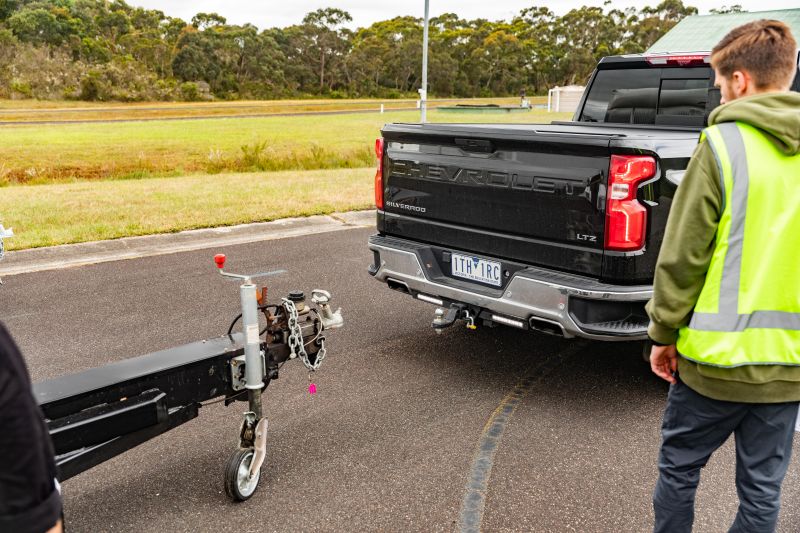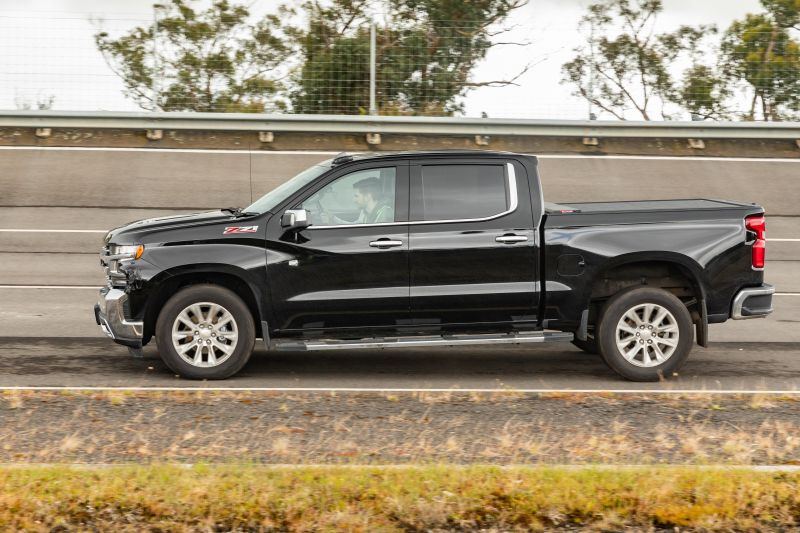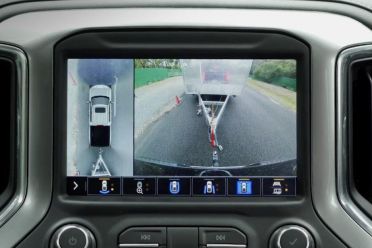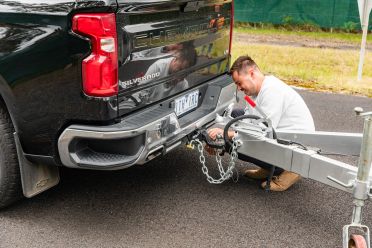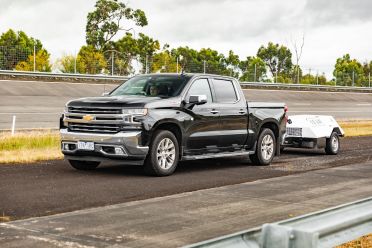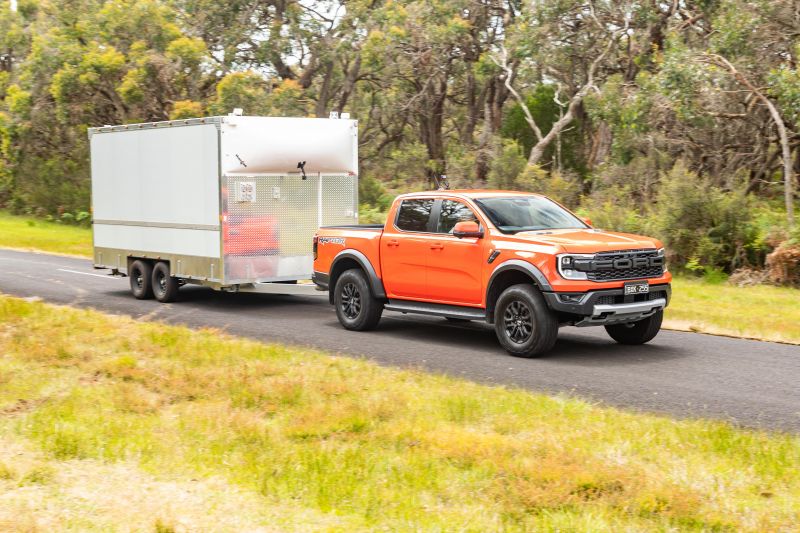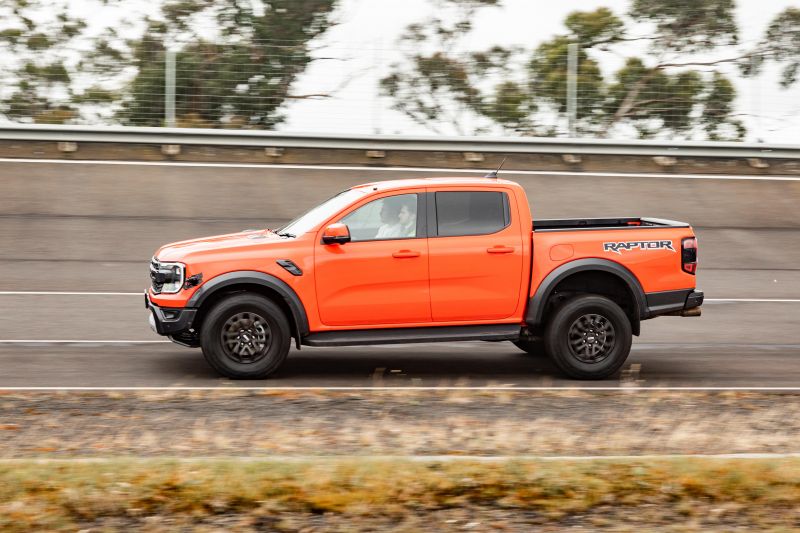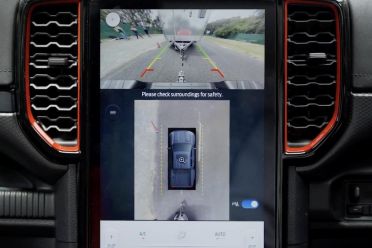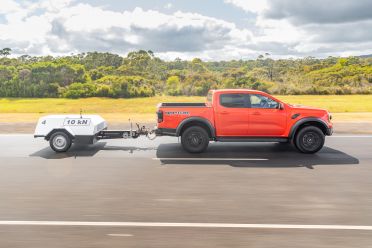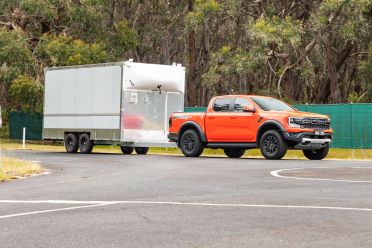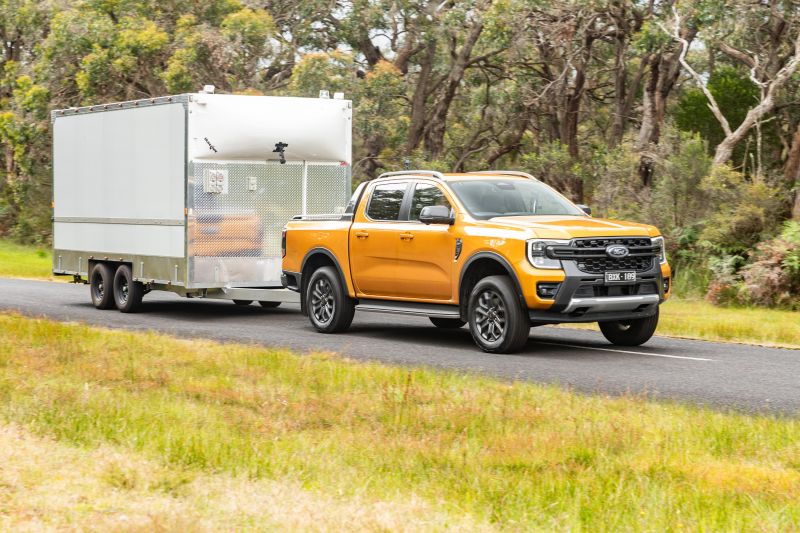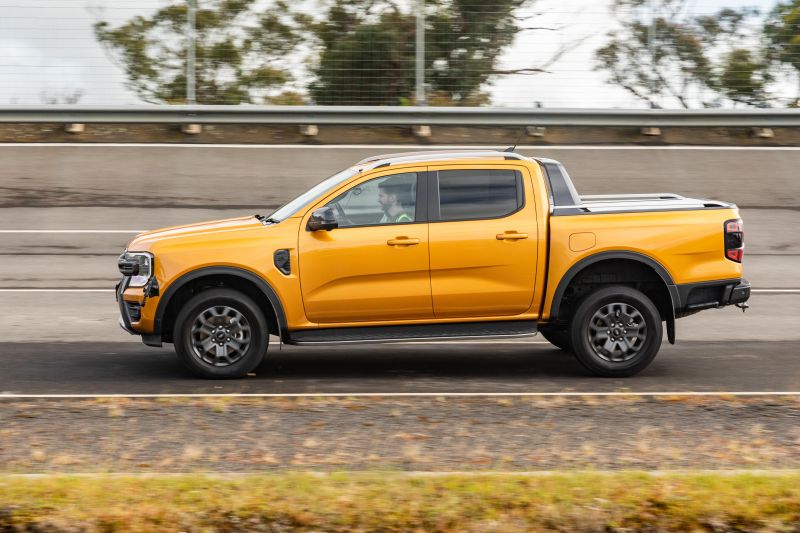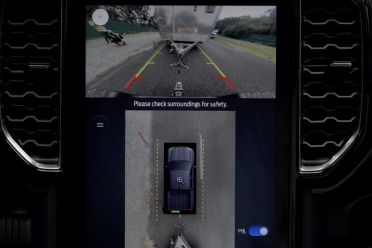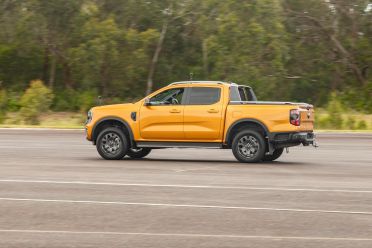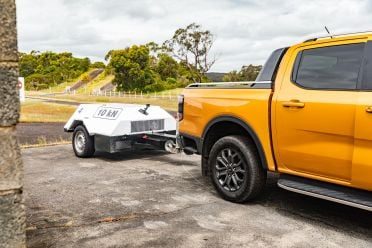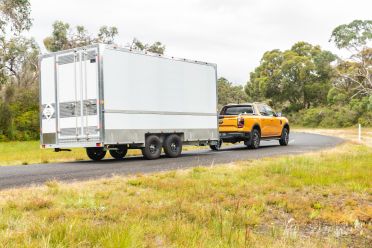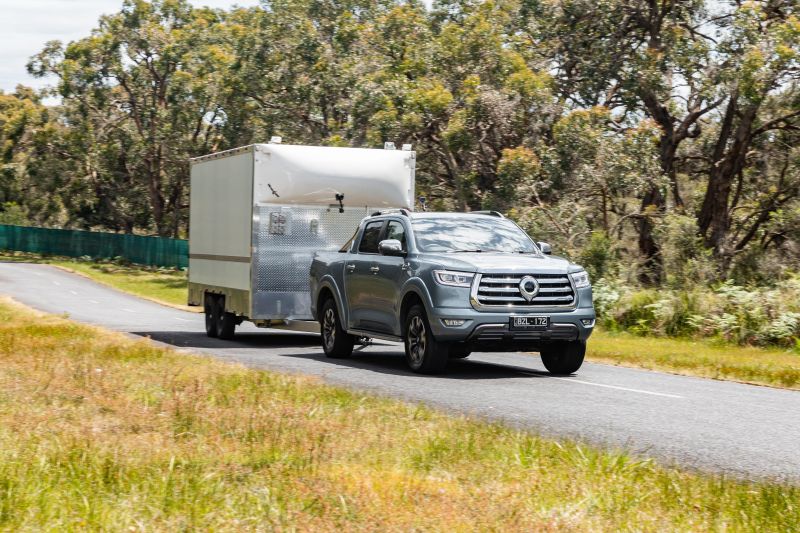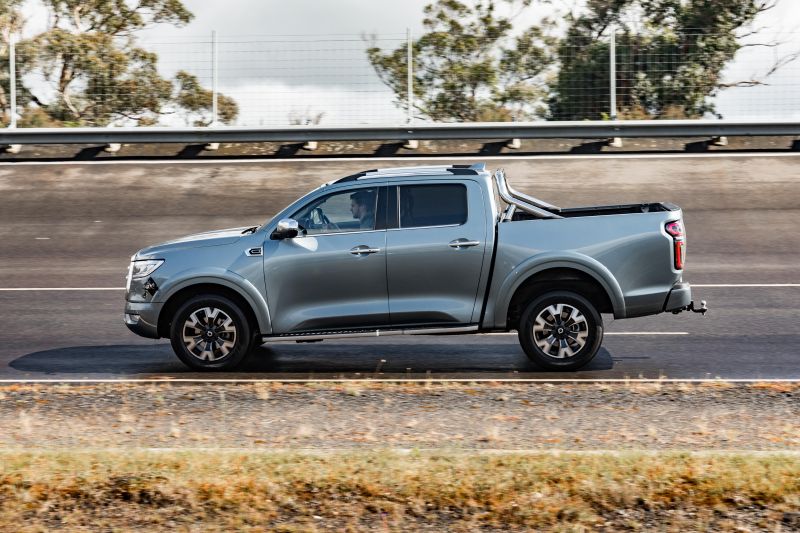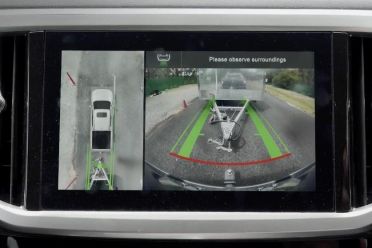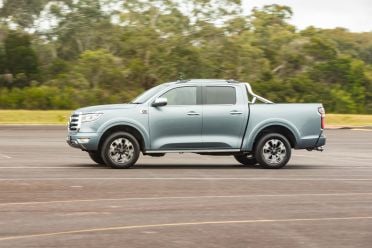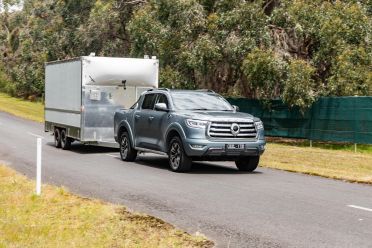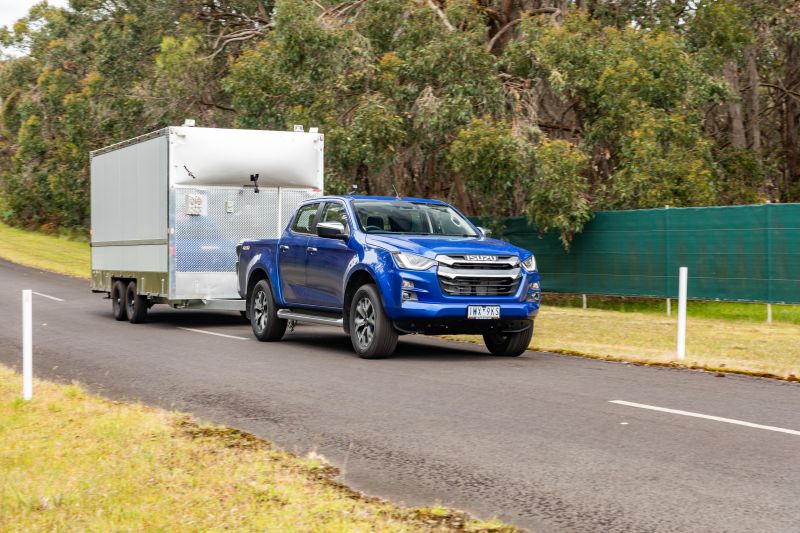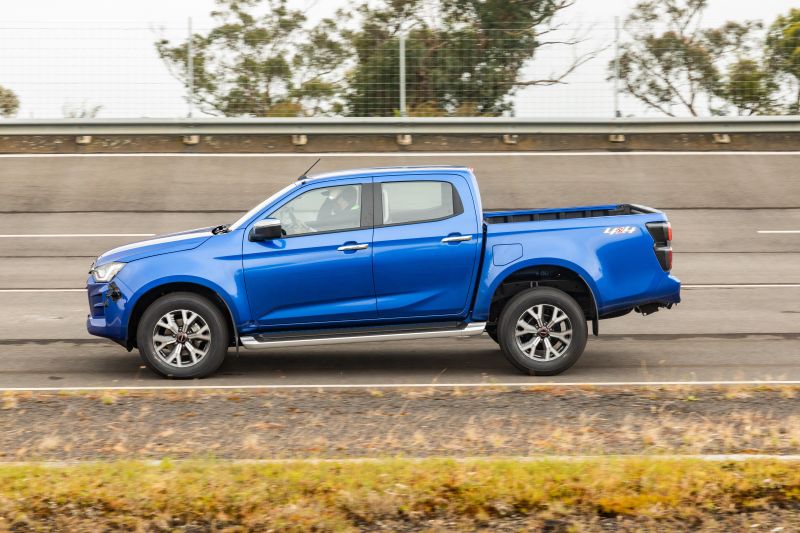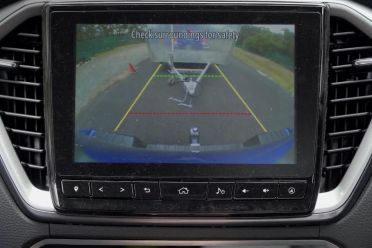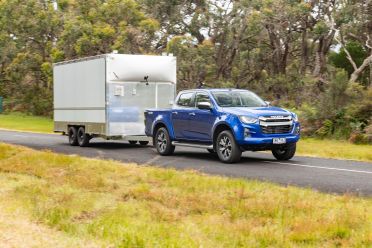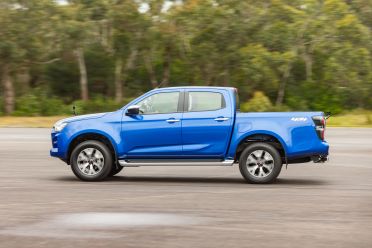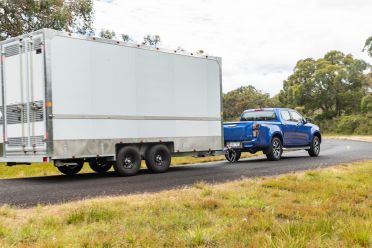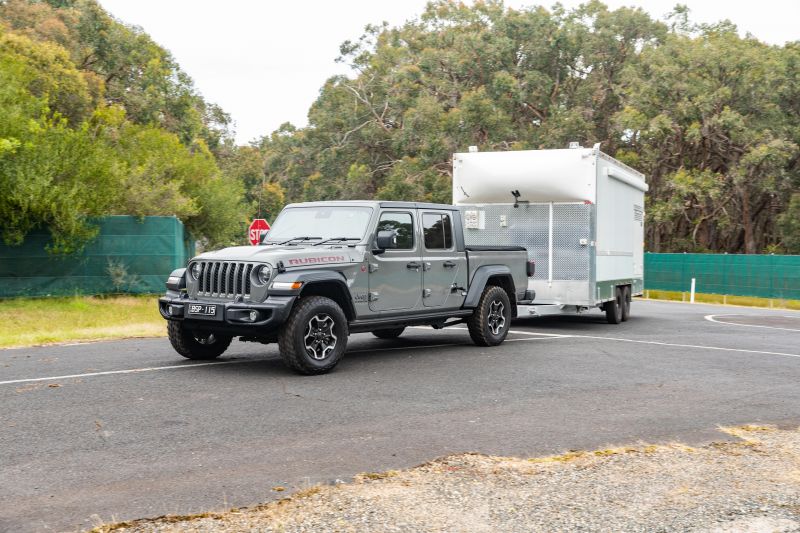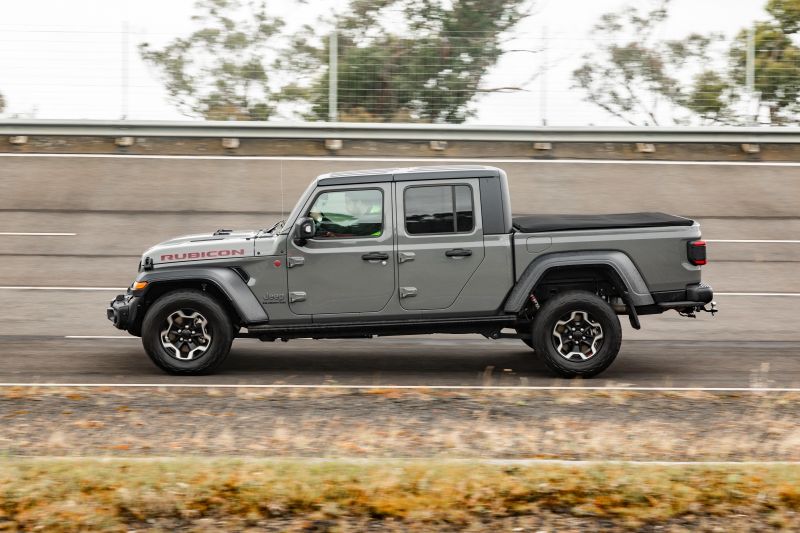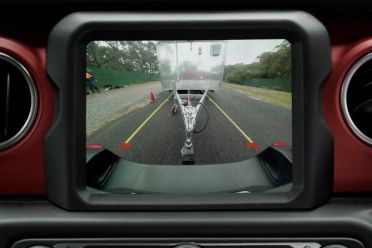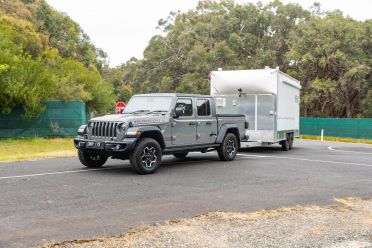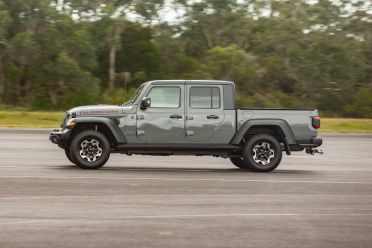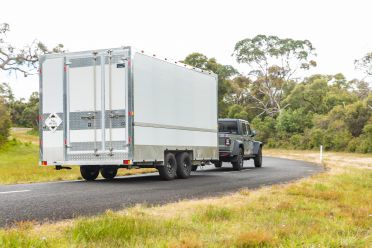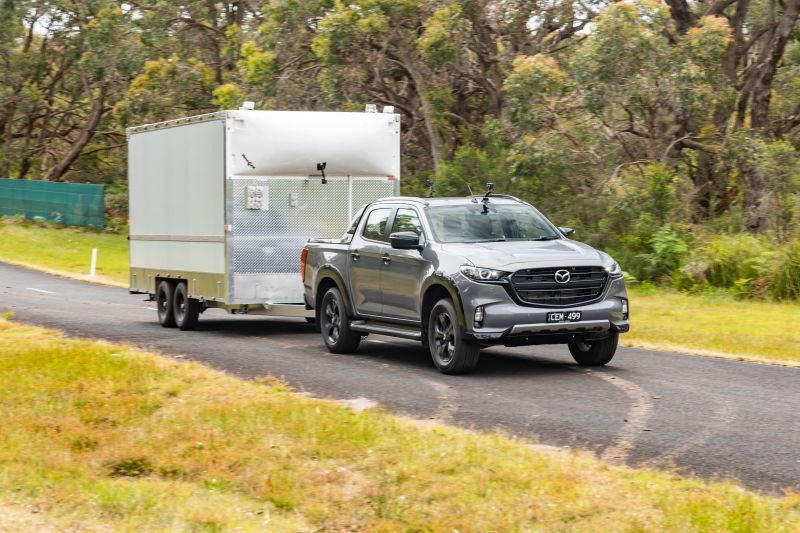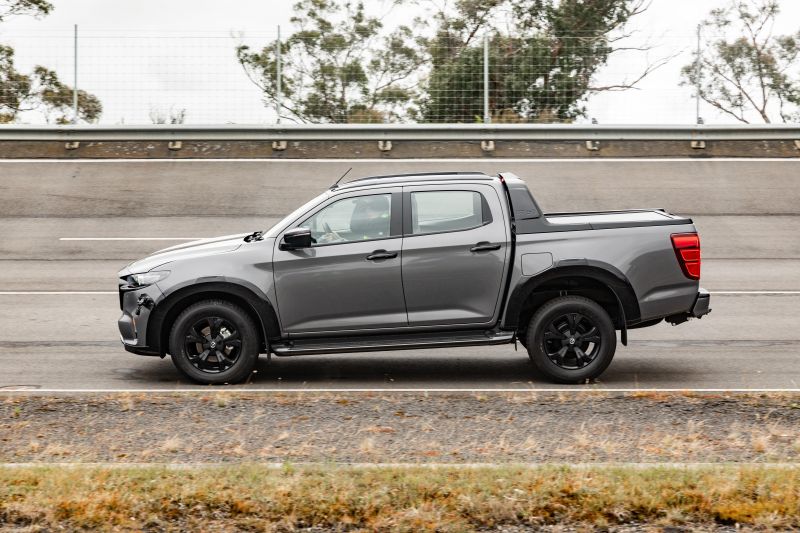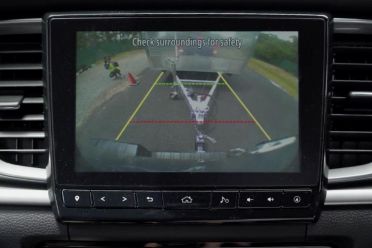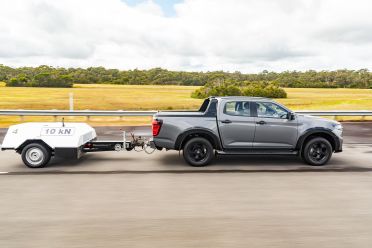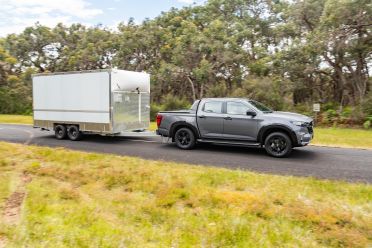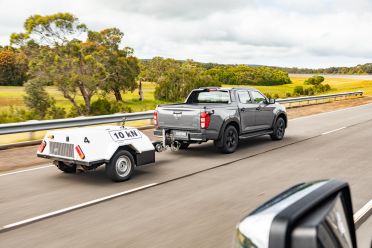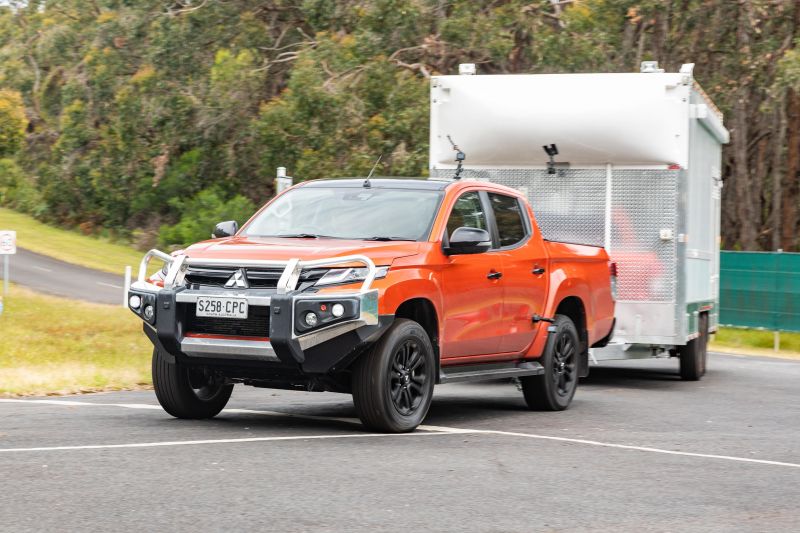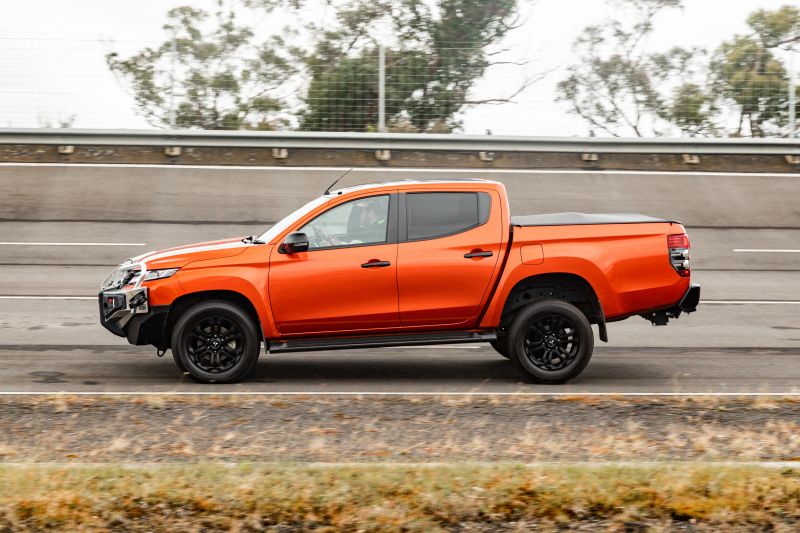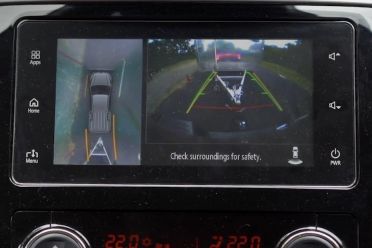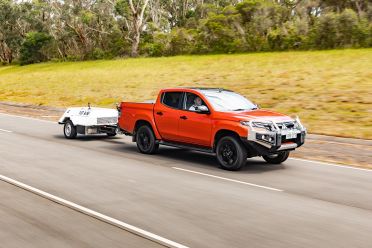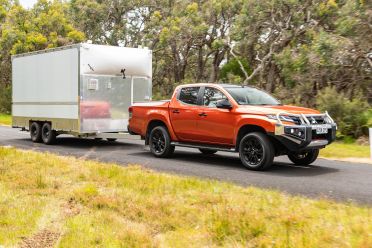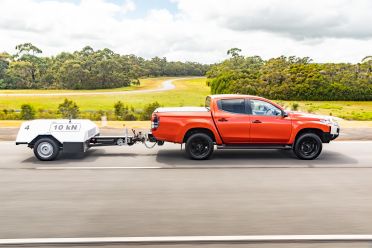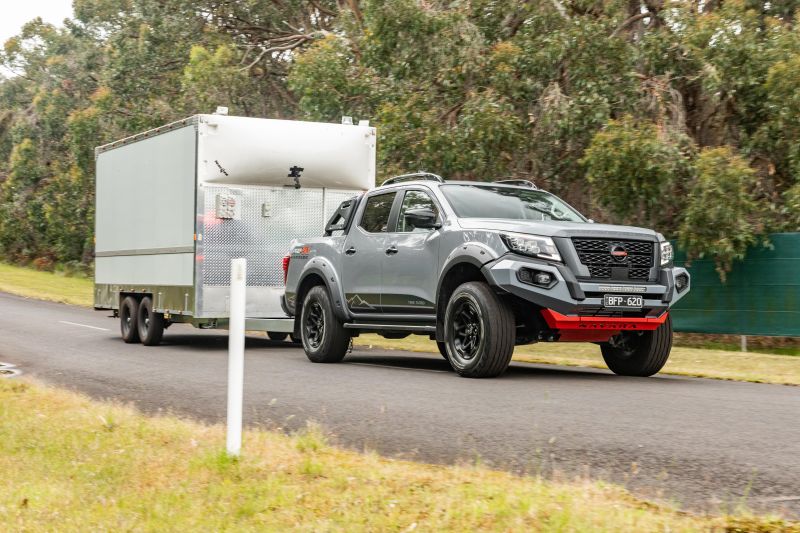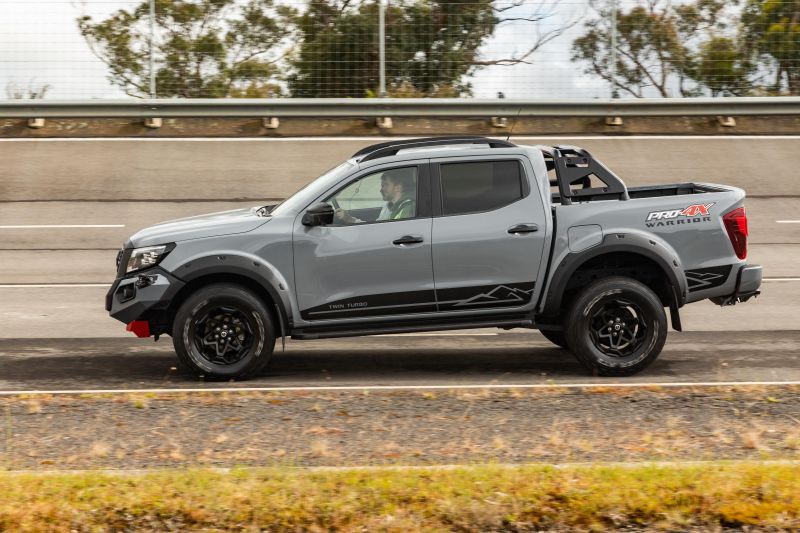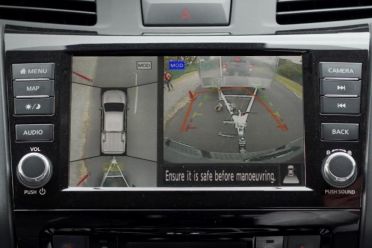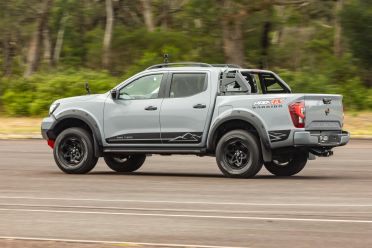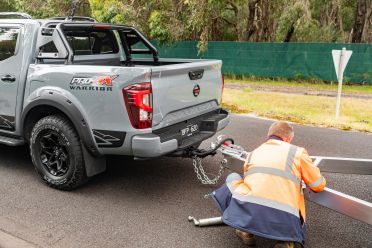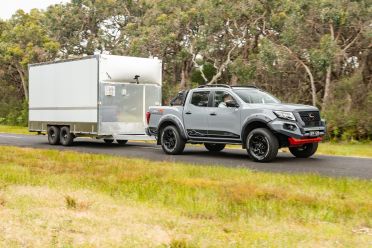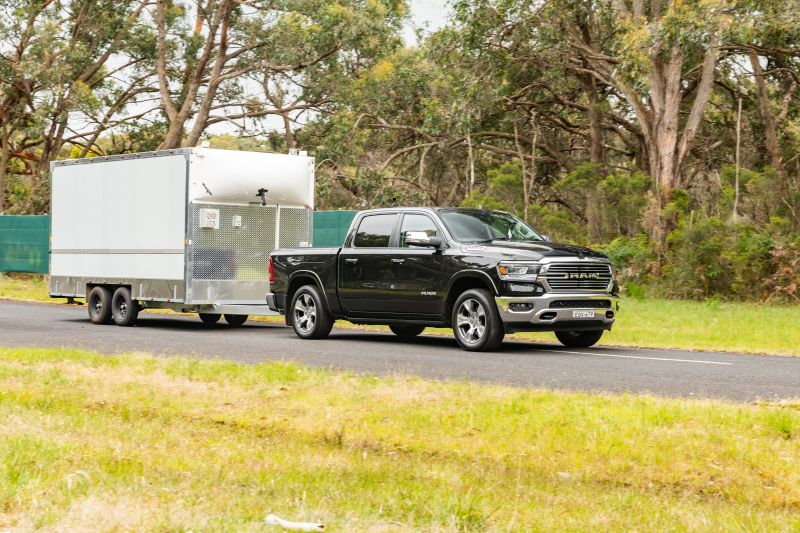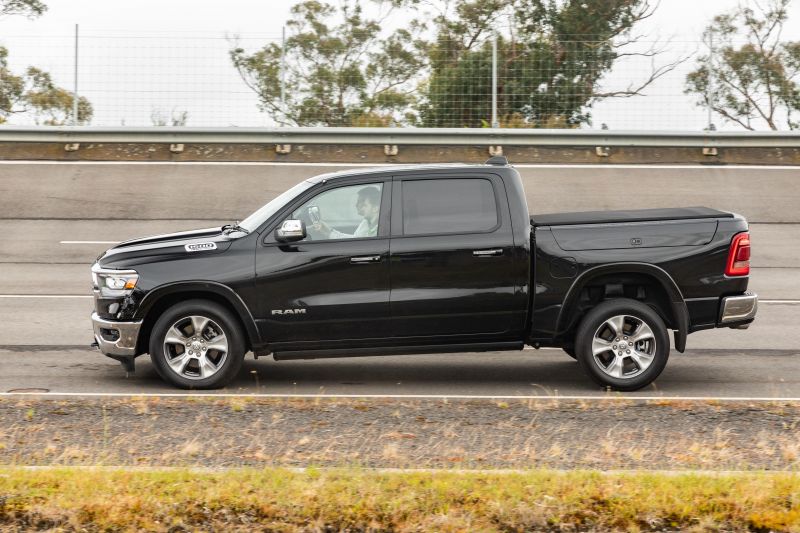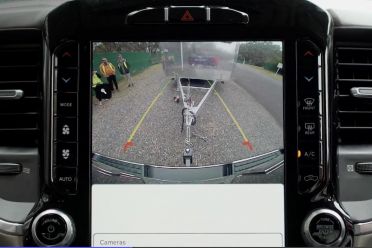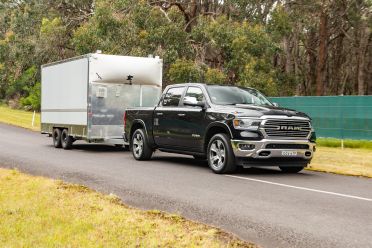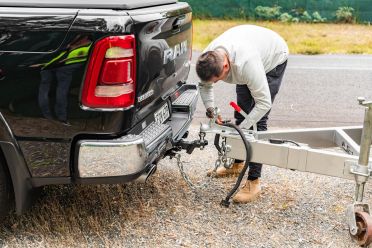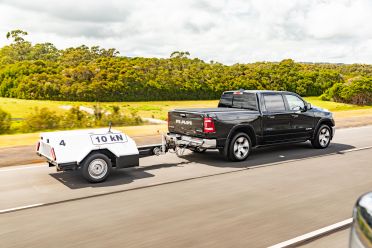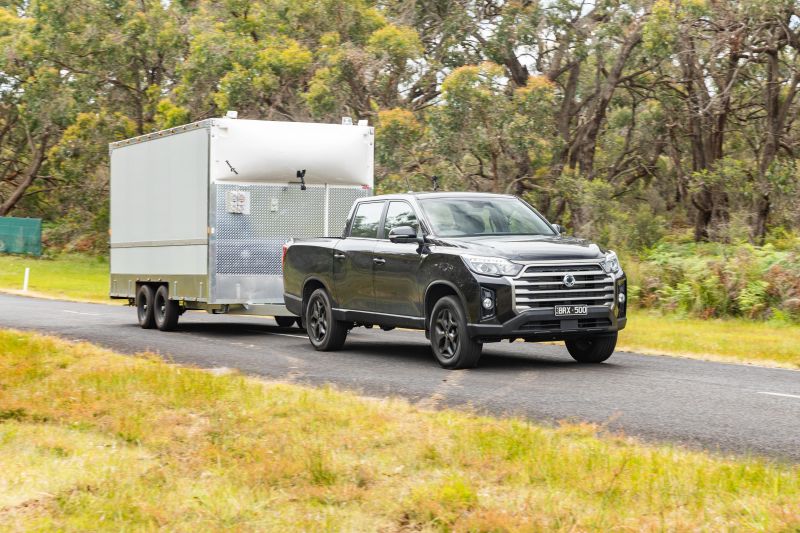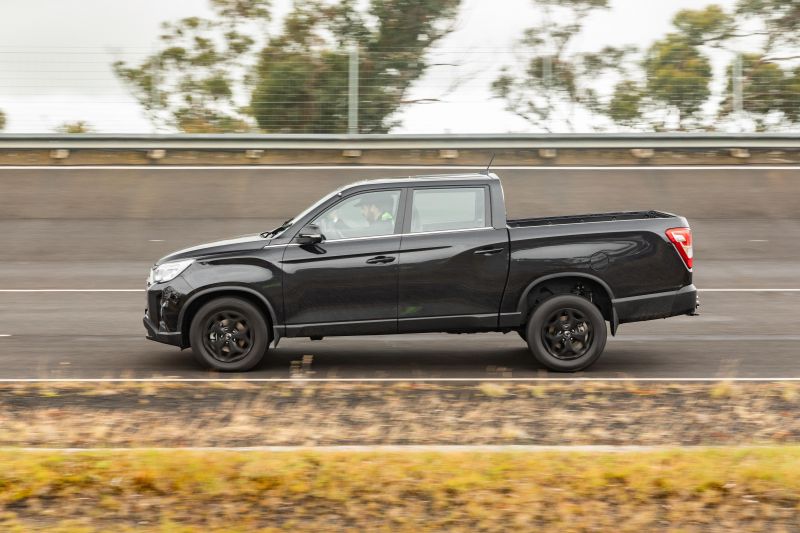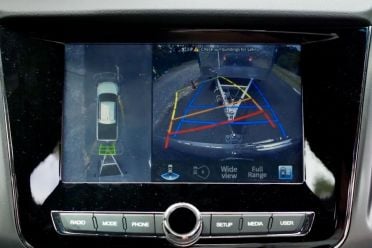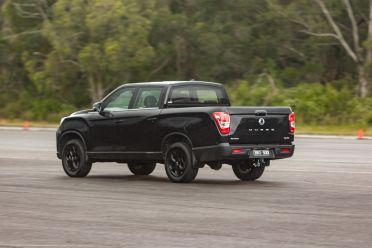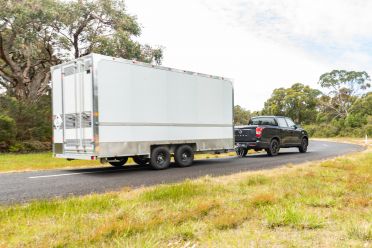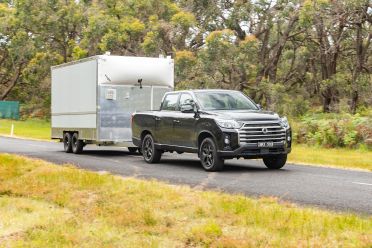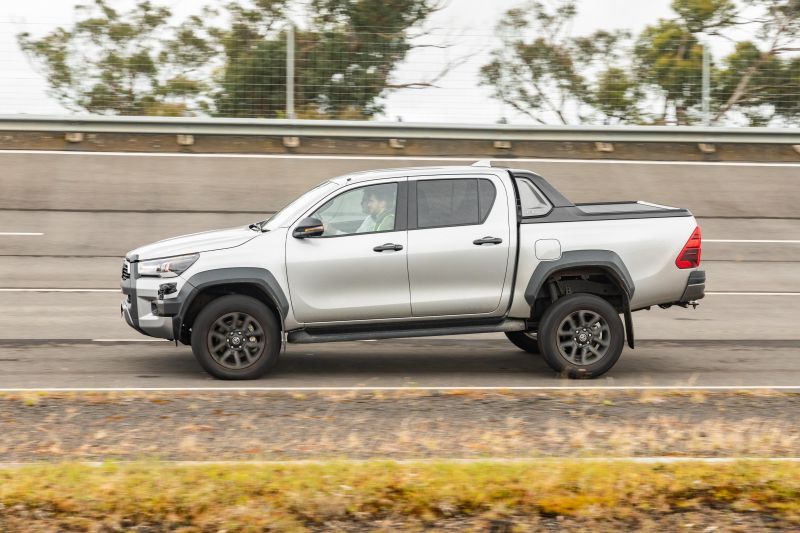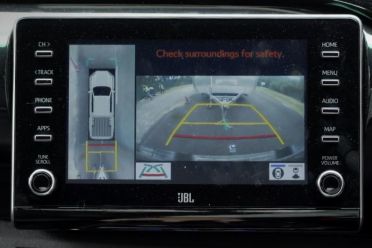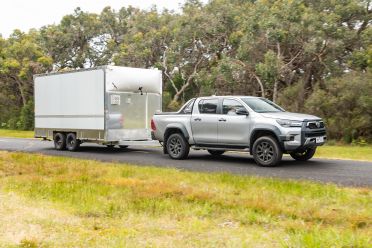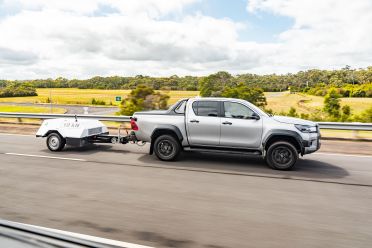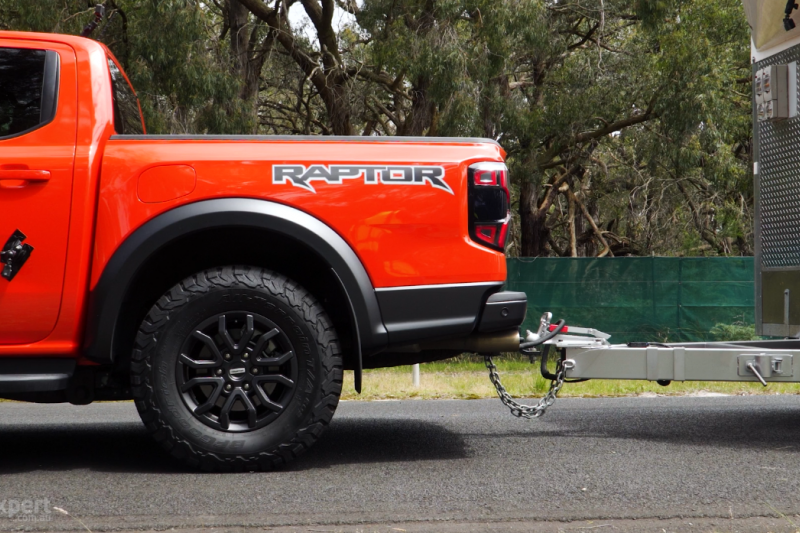In this part of our sprawling 12-ute megatest, we take a look at how they perform while towing.
In order to facilitate such a big group of cars, we used a closed testing facility, including a high-speed bowl and a test road with elevation changes.
Unlike some ute tests that focus on subjective rather than objective testing, we wanted to offer readers a healthy mixture of both.
As with the rest of our ute content, this written article is designed to support the detailed video hosted by Paul Maric and embedded below. We strongly encourage you to watch!
MORE: Performance tests and drag
MORE: Dynamometer tests
The tests
Unladen
To set some controls, we put all of our utes on a high-speed bowl and Vbox-tested their 0-100km/h acceleration time and 100km/h to zero braking distance.
We also measured their fuel economy at a constant 100km/h around the bowl – not to come away with a definitive efficiency number, but rather to set comparative figures.
Trailer dyno
We got our hands on a state-of-the-art trailer dynamometer with a variable load retarder that allowed us to impart up to 10kN of resistive load to the tow vehicle.
What does this mean in real terms? Think of the trailer dynamometer as an anchor. Varying the dynamometer load allows us to change the weight of that anchor.
This weighted anchor allows us to simulate a long steep climb for the tow vehicle, which ultimately puts immense load on the engine.
This 1600kg trailer dynamometer is wirelessly linked up to a computer that lets the operator adjust the degree of resistance force as measured in kilonewtons (kN) – in our tests we set it to 3kN, which simulates a fairly steep ascent, but one that should be within each ute’s abilities.
With this trailer attached we measured the 0-100km/h time, as well as the 0-90km/h time, because as you’ll see not all of the competitors made it to three digits. Then we did another fuel economy lap to see how hard the engine was working with the load active.
Again, these fuel efficiency numbers are not designed to be definitive for all user cases in all situations, but rather to serve as comparative car-to-car data.
2500kg van towing
We hitched each ute to a 2500kg trailer and tackled a 5km road representative of regional Australia, including a 15 per cent climb, plus a descent to test engine braking, and some choppy bitumen to test the ride quality.
This test is less data-driven, and about Paul’s seat-of-the-pants feel – as he describes in the video.
Notes
All vehicles were fitted with the stock tyres each variant came with, set to their recommended tyre pressures. We used GPS speed data rather than speedo data, and had to battle intermittent drizzle as flagged in the video.
Just straight to a particular ute by clicking these links, scroll to read the full breakdown alphabetically, or just jump right to the data tables. We recommend you watch the video, even just for one car, for the full experience.
Chevrolet Silverado LTZ Premium
Ford Ranger Raptor
Ford Ranger Wildtrak
GWM Ute Cannon-X
Isuzu D-Max LS-U+
Jeep Gladiator Rubicon
Mazda BT-50 SP
Mitsubishi Triton GSR
Nissan Navara Pro-4X Warrior
Ram 1500 Laramie
SsangYong Musso XLV Ultimate
Toyota HiLux Rogue
Chevrolet Silverado LTZ
Key specs
- Engine: 6.2-litre petrol V8
- Power: 313kW @ 5600rpm
- Torque: 624Nm @ 4100rpm
- Towing capacity: 4500kg
- Kerb weight: 2540kg
- Gross Vehicle Mass: 3300kg
- Gross Combination Mass: 7160kg
- 4×4 system: Full-time
- Transmission: 10-speed auto
Results
- Unladen 0-100km/h: 6.5s
- Unladen 100-0km/h: 42.1m
- 0-90km/h with 3kN trailer: 10.2s
- 0-100km/h with 3kN trailer: 11.2s
- Fuel econ unladen: 10.4L/100km
- Fuel econ with trailer: 36.5L/100km
Field notes
Sometimes there’s no replacement for displacement, as the Chevy’s 6.2-litre naturally aspirated V8 shows. It took just 6.5 seconds to get to 100km/h sans trailer and 11.2 seconds to get to 100km/h with the 3kN resistance trailer hitched. That’s faster than several of our utes were when tested with nothing attached!
As Paul found on the testing road with the 2.5t trailer, the Chevy’s mass meant it felt in charge, rather than being led by the trailer.
It flew up the hill climb gaining speed all the way, with its Tow mode holding lower gears for longer, and held its speed constant in third gear down the hill without needing brakes – essential here considering we had a system fault with the trailer braking! You can hold gears using the manual controls on the column shifter.
One disappointing aspect was the lack of body control over the choppy and wavy road surface, with the driver finding themselves wobbling around more than in the Ram.
The Silverado comes standard with an Advanced Trailer System with menus for the pre-departure checklist, light sequencing tests, maintenance reminders, and security alerts. The system can also provide trailer electrical diagnostics and monitor tyre pressure. Note too the multi-view 360-degree camera for hitching.
Overall it was the second-fastest vehicle off the mark with and without the trailer, and had the fourth-shortest overall stopping distance (impressive for such a heavy car). Its fuel efficiency was poor, as you’d expect, with its 10.4L/100km unladen figure ballooning to 36.5L/100km when towing – up 250 per cent.
Ford Ranger Raptor
Key specs
- Engine: 3.0-litre twin-turbo petrol V6
- Power: 292kW @ 5650rpm
- Torque: 583Nm @ 3500rpm
- Towing capacity: 2500kg
- Kerb weight: 2431kg
- Gross Vehicle Mass: 3130kg
- Gross Combination Mass: 5370kg
- 4×4 system: Full-time
- Transmission: 10-speed auto
Results
- Unladen 0-100km/h: 6.4s
- Unladen 100-0km/h: 50.5m
- 0-90km/h with 3kN trailer: 9.0s
- 0-100km/h with 3kN trailer: 10.9s
- Fuel econ unladen: 11.6L/100km
- Fuel econ with trailer: 36.5L/100km
Field notes
The Raptor has the lowest towing capacity here – our 2500kg trailer sat at its uppermost limit – but that’s not because it’s lacking power or torque from its mighty twin-turbocharged petrol V6, which sounds absolutely epic under acceleration.
It was even faster than the V8 Chevy off the mark without a load, taking 6.4 seconds to get to 100km/h, and remained the quickest accelerator with the trailer too, taking a mere 10.9sec to 100km/h.
As we found on the 2.5t trailer test the Raptor has a fantastic 360-degree camera view and well-integrated factory brake controller with a simple interface to change the gain levels. Rangers, like the Chevy, let you go through a light sequence check via the touchscreen, or even via your FordPass app.
The off-road suspension really gave the Raptor a brilliantly comfortable ride quality over our testing road, absorbing hits while keeping the body settled over undulations, and hauled arse up the 15 per cent climb when loaded to its towing capacity. Sounds great, too.
It also engine braked its way down the hill effortlessly, and comes with paddle shifters unlike other Rangers. One critique though was the unladen 100-0km/h brake test on account of the off-road tyres – at 50.5m it had the third-worst stopping distance.
Overall it was the quickest-accelerating ute unladen and with the trailer. It was middle of the pack when measuring the change in fuel economy unladen versus laden, with the figure going from 11.6L/100km to 36.5L/100km – a 214 per cent increase.
Ford Ranger Wildtrak V6
Key specs
- Engine: 3.0-litre turbo-diesel V6
- Power: 184kW @ 3250rpm
- Torque: 600Nm @ 1750rpm
- Towing capacity: 3500kg
- Kerb weight: 2353kg
- Gross Vehicle Mass: 3350kg
- Gross Combination Mass: 6400kg
- 4×4 system: Full-time
- Transmission: 10-speed auto
Results
- Unladen 0-100km/h: 8.9s
- Unladen 100-0km/h: 46.6m
- 0-90km/h with 3kN trailer: 12.7s
- 0-100km/h with 3kN trailer: 15.9s
- Fuel econ unladen: 9.0L/100km
- Fuel econ with trailer: 28.3L/100km
Field notes
If you’re someone who tows regularly, the Ranger V6 diesel is among the best options you can buy in terms of performance. While the Raptor was punchier, the diesel’s towing capacity is 3500kg, up a tonne.
As the spec-sheet figures suggest (it’s the most powerful and torque-rich diesel on test) it performed better than all the other diesel entrants here. Its zero to 100km/h with no trailer was 8.9 seconds, which grew to 15.9 seconds with the 3kN trailer hitched.
It has that same great 360-degree camera in Wildtrak spec level as tested, and the same cool features as the Raptor such as an integrated brake controller with gain adjustments via the touchscreen, as well as the ability to run a trailer light sequence by itself. You can also program your trailer length into the screen, which adjusts the blind-spot monitor.
It was effortless with the 2.5t trailer, run in its Tow/Haul driveline mode, which holds lower gears longer. Despite having 10 speeds, the transmission’s ratios felt well-spaced, and it pulled up the ascent with no hesitation, gaining speed all the way. It also has the reassurance of full-time 4WD.
The Australian-tuned ride quality over undulations proved to be better than average with only a hint of bounciness, ditto the engine braking from the tractable diesel – although we’d suggest the buttons on the gear shifter to engage gears manually are annoying. Paddles would be a better option.
All told the Ranger V6 diesel was the fourth-fastest vehicle (and fastest diesel) to 100km/h – both with and without the trailer. Despite all-round disc brakes it’s stopping distance was in the lower half, but its fuel economy change (9.0L/100km no trailer to 28.3L/100km) was slightly better than the group average.
GWM Ute Cannon-X
Key specs
- Engine: 2.0-litre turbo-dieseI 4cyl
- Power: 120kW @ 3600rpm
- Torque: 400Nm @ 1500rpm
- Towing capacity: 3000kg
- Kerb weight: 2100kg
- Gross Vehicle Mass: 3130kg
- Gross Combination Mass: 5545kg
- 4×4 system: Full-time
- Transmission: 8-speed auto
Results
- Unladen 0-100km/h: 12.5s
- Unladen 100-0km/h: 46.6m
- 0-90km/h with 3kN trailer: 28.7sec
- 0-100km/h with 3kN trailer: FAIL
- Fuel econ unladen: 10.5L/100km
- Fuel econ with trailer: 28.6L/100km
Field notes
The GWM’s 2.0-litre four-cylinder diesel has the lowest power (120kW) and torque (400Nm) figures here, thus its 3000kg braked towing capacity is 500kg short of the class benchmark. In its favour is a ZF eight-speed automatic and its full-time 4×4 system.
With our VBox engaged we found it third-slowest here, at 12.5 seconds to 100km unladen, increasing to 28.7 seconds from 0-90km/h with the 3kN trailer attached. It was one of the seven vehicles that failed to pass 100km/h with the resistance trailer, yet in no test was it the slowest vehicle here.
We had an issue with the cruise control system, which failed to maintain a speed with the 3kN trailer attached. The transmission didn’t kick down a gear and so we slowed way back to 40km/h before Paul decided to override it with a press of the accelerator. This is why we took the low fuel consumption with some degree of skepticism.
In regards to the 2.5t trailer, the 360-degree camera was helpful thanks to high resolution, and it managed to build speed all the way up the long hill climb – albeit in 1km/h increments, with that engine sounding over-worked. Again though, it got there, and the transmission logic was smarter in this test than it priced to be on the 3kN trailer constant-speed bowl loop.
In third gear (manual override via paddle shifters) it kept a constant speed of 60km/h down the hill without brakes, but its body control over the choppy road surface was below-par, as Paul’s head movement in the video shows. Some float or porpoising was evident, making an aftermarket suspension upgrade something we’d strongly consider.
Overall it was the third-slowest to 100km/h sans trailer, the equal-second slowest with the trailer, and has the equal-fourth-worst stopping distance. Its fuel economy increased with the trailer from 10.5L/100km to 28.6L/100km (up 172 per cent) but as we indicated earlier, we’re taking this with a pinch of salt.
Isuzu D-Max LS-U+
Key specs
- Engine: 3.0-litre turbo-diesel 4cyl
- Power: 140kW @ 3600rpm
- Torque: 450Nm @ 1600rpm
- Towing capacity: 3500kg
- Kerb weight: 2175kg
- Gross Vehicle Mass: 3100kg
- Gross Combination Mass: 6000kg
- 4×4 system: Part-time
- Transmission: 6-speed auto
Results
- Unladen 0-100km/h: 11.3s
- Unladen 100-0km/h: 41.9m
- 0-90km/h with 3kN trailer: 18.6s
- 0-100km/h with 3kN trailer: FAIL
- Fuel econ unladen: 9.1L/100km
- Fuel econ with trailer: 22.2L/100km
Field notes
The D-Max is highly popular with people who tow, with its truck-sourced 3.0-litre diesel carrying a strong reputation for reliability. Its 3.5t towing capacity is par, though its outputs fall short of the Ranger and HiLux. The engine is mated to a six-speed automatic transmission and part-time 4×4, meaning you must drive RWD on tarmac.
In terms of performance data it’s as middle-of-the-pack as its outputs suggest. We recorded an 11.3-second standing zero to 100km/h time without a trailer, climbing to 18.6 seconds to 90km/h with the 3kN trailer. It was part of the group that failed to make it to 100km/h, but we will caveat this by saying every single four-cylinder fell short of the mark here.
When hitching up the 2.5t trailer we found the reverse-only camera to be relatively clear in terms of resolution, but also slightly offset. We also noted that the trailer brake connection disengaged the blind-spot monitoring system for you.
Initial impressions on the test road were that the 3.0-litre felt strong and confidence-inspiring, albeit noisy. The electric steering was very light, the gearbox decisive and well-tuned despite being short on ratios, and it picked up speed all the way to the top of the hill.
Higher-speed ride and body control over the choppy decision was deemed good, with the suspension keeping the vehicle stable and comfortable, while its engine braking down the slope kept speed constant.
Overall it was the seventh-fastest to 100km/h without a trailer, and eighth-fastest to 90km/h with the trailer. Its fuel efficiency indicator on our unladen lap was an outstanding 9.1L/100km, while its 22.2L/100km figure when towing was the best overall. We’re a touch skeptical here because it did far better than its Mazda BT-50 twin – perhaps because we inadvertently had the measurements set to km/l rather than l/100km?
One area we cannot argue with was the braking test, with the D-Max and BT-50 twins managing the shortest 100-0km/h stopping distances of all utes on test with the sole exception of the Ram 1500, which costs twice as much. This is despite the old-world drum brakes fitted at the rear wheels compared to discs for several others.
Jeep Gladiator Rubicon
Key specs
- Engine: 3.6-litre V6 petrol
- Power: 209kW @ 6400rpm
- Torque: 347Nm @ 4100rpm
- Towing capacity: 2721kg
- Kerb weight: 2242kg
- Gross Vehicle Mass: 2935kg
- Gross Combination Mass: 5656kg
- 4×4 system: Full-time
- Transmission: 8-speed auto
Results
- Unladen 0-100km/h: 10.3s
- Unladen 100-0km/h: 45.9m
- 0-90km/h with 3kN trailer: 16.1s
- 0-100km/h with 3kN trailer: 28.9s
- Fuel econ unladen: 11.3L/100km
- Fuel econ with trailer: 42.7L/100km
Field notes
Of all the utes tested here, the Gladiator is one of the least likely to be purchased as a towing vehicle. Unless the trailer carries a speed boat or some dirt bikes, that is. This explains its 2721kg towing capacity, which is the second-worst here.
Its 3.6-litre naturally aspirated V6 petrol engine has the least torque (347Nm) here, and it’s on stream at a higher point in the rev band, meaning the engine must spin that much quicker. On the plus side it has a good amount of power (209kW), eight forward gear ratios, and full-time 4WD.
It was a little sluggish off the mark with an unladen 0-100km/h time of 10.3 seconds, however it was able to overcome its limitations while towing, eclipsing the 100km/h barrier with the 3kN trailer in 28.9 seconds. Sure it was noisy as hell, but it beat most of the other utes here, which we did not expect.
The camera view is reverse only, but excellent in terms of resolution, and the off-road suspension (Fox shocks included) and chunky tyres offered a good balance of comfort and control. Paul did note the excessive wind noise and the vague steering however. It kept gaining speed up the hill, and happily coasted down at a set speed in third gear without needing brakes.
Overall the Jeep was the fifth-fastest to 100km/h without a trailer, and just one of five that passed 100km/h with the 3kN trailer. Its 0-90km/h trailer acceleration time was fifth overall at 16.1 seconds, but the trade-off is its drinking problem – it used 11.3L/100km on the unladen lap (second-worst here) and 42.7L/100km with the trailer – worst here, and a 277 per cent jump.
Its mid-level braking distance result (seventh) was pretty good considering other vehicles with similarly off-road-oriented tyres fared worse.
Mazda BT-50 SP
Key specs
- Engine: 3.0-litre turbo-diesel 4cyl
- Power: 140kW @ 3600rpm
- Torque: 450Nm @ 1600rpm
- Towing capacity: 3500kg
- Kerb weight: 2208kg
- Gross Vehicle Mass: 3100kg
- Gross Combination Mass: 6000kg
- 4×4 system: Part-time
- Transmission: 6-speed auto
Results
- Unladen 0-100km/h: 11.4s
- Unladen 100-0km/h: 42m
- 0-90km/h with 3kN trailer: 18.1s
- 0-100km/h with 3kN trailer: FAIL
- Fuel econ unladen: 8.8L/100km
- Fuel econ with trailer: 26.4L/100km
Field notes
The BT-50 uses Isuzu’s 3.0-litre diesel with 140kW and 450Nm, and shares its 3.5t towing capacity, six-speed automatic transmission and part-time 4×4. Given we had the BT-50 SP grade, it was a touch heavier than the lower-grade D-Max LS-U+, but not to enough of a degree to make much difference.
Reassuringly its figures were almost the same as the Isuzu’s: 11.4 seconds to 100km/h (0.1sec slower) before the trailer and 18.1 seconds to 90km/h with the trailer (actually 0.5s faster). It failed to make it to 100km/h with that resistance trailer attached.
When hitching up the 2.5t trailer we found the reverse-only camera to be relatively clear in terms of resolution, but also slightly offset. We also noted that the trail brake connection disengaged the blind-spot monitoring system for you.
We observed that it was pretty much the same, seat-of-the-pants, as the Isuzu, as you’d expect. The 3.0-litre felt strong and confidence-inspiring, albeit noisy, the electric steering was very light, the gearbox decisive and well-tuned despite being short on ratios, and it picked up speed all the way to the top of the hill.
Higher-speed pride and body control over the choppy section was deemed solid, with the suspension keeping the vehicle stable and comfortable, while its engine braking down the slope kept speed constant.
Overall it was the eighth-fastest to 100km/h without a trailer, and sixth-fastest to 90km/h with the trailer. Its fuel efficiency indicator on our unladen lap was a benchmark 8.8L/100km (it had a few more kilometres on the odometer than the Isuzu), yet its 26.4L/100km figure was inferior, for some odd reason. Yet overall it was the second-most efficient here with the trailer. Big tick.
As flagged earlier the D-Max and BT-50 twins managed the shortest 100-0km/h stopping distances of all utes on test with the sole exception of the Ram 1500, which costs twice as much.
Mitsubishi Triton GSR
Key specs
- Engine: 2.4-litre turbo-diesel 4cyl
- Power: 133kW @ 3500rpm
- Torque: 430Nm @2500rpm
- Towing capacity: 3100kg
- Kerb weight: 1999kg (excludes bullbar)
- Gross Vehicle Mass: 2900kg
- Gross Combination Mass: 5885kg
- 4×4 system: Full-time
- Transmission: 6-speed auto
Results
- Unladen 0-100km/h: 13.1s
- Unladen 100-0km/h: 43.2m
- 0-90km/h with 3kN trailer: 28.7s
- 0-100km/h with 3kN trailer: FAIL
- Fuel econ unladen: 9.7L/100km
- Fuel econ with trailer: 30.1L/100km
Field notes
The Triton’s 2.4-litre diesel’s outputs (133kW and 430Nm) are lower than most vehicles on test, and so too is its 3100kg towing capacity. In its favour is the clever 4×4 system with a full-time mode for road use.
This was reflected in our performance tests, where the Mitsubishi proved to be the second-slowest to 100km/h (13.1sec) without a trailer and equal-second-slowest with the trail (0-90km/h in 28.7sec). As you might expect it failed to make it to 100km/h with the 3kN trailer.
While the camera view is 360-degrees, as you can see it’s projected on a small screen, looks grainy, and the lens is offset.
It managed to build speed up the hill road with the 2.5t trailer connected but only by the skin of its teeth, and engine braking was made easy by pulling down a cog with those comically oversized paddle shifters.
As the wavering in Paul’s voice shows, its ride quality was quite unsettled and jiggly. That big rear overhang (result of the short wheelbase) might be one reason why it didn’t feel as stable and as in control as many of the other utes. Indeed, we found the ride quality with the trailer to be the worst of any vehicle here.
The Triton was bang-on middle-of-the-back in terms of stopping distance (equal-fifth with the HiLux) despite its rear drums, likely down to its comparatively light kerb weight. Fuel efficiency went from 9.7L/100km unladen to 30.1L/100km with the trailer, a 210 per cent increase that was fifth-best here – a touch surprising given how much it sounded like it was battling.
Nissan Navara Pro-4X Warrior
Key specs
- Engine: 2.3-litre twin-turbo diesel 4cyl
- Power: 140kW @ 3750rpm
- Torque: 450Nm @ 1500rpm
- Towing capacity: 3500kg
- Kerb weight: 2224kg
- Gross Vehicle Mass: 3250kg
- Gross Combination Mass: 5910kg
- 4×4 system: Part-time
- Transmission: 7-speed auto
Results
- Unladen 0-100km/h: 13.2s
- Unladen 100-0km/h: 53.7m
- 0-90km/h with 3kN trailer: 29.8s
- 0-100km/h with 3kN trailer: FAIL
- Fuel econ unladen: 9.4L/100km
- Fuel econ with trailer: 33.3L/100km
Field notes
The Navara’s twin-turbocharged 2.3-litre four-cylinder engine (140kW and 450Nm) matches the Isuzu and Mazda on paper, but its performance in our test didn’t. This engine is mated to a seven-speed automatic and part-time 4×4 system.
Its 13.2-second 0-100km/h time was the worst here, and in our separate test where we put all of these utes on a performance dyno, it proved to be the second-least powerful vehicle here, narrowly ahead of the GWM. It also took the longest to accelerate to 90km/h with the 3kN trailer, at 29.8 seconds – more than double the time taken by the Ranger V6 diesel.
In fairness this is the Pro-4X Warrior variant that’s been modified for 4×4 use, with chunky all-terrain tyres, a heavy bullbar, and a suspension update that adds clearance and GVM. These features make it great off-road, but add weight and resistance to the vehicle, which makes the engine work that bit harder.
The surround-view camera is quite low-resolution. On the road loop we found the ride quality to be largely excellent in terms of comfort and body control, which is a credit to Melbourne engineering firm Premcar for the work it did engineering this variant for Nissan Australia.
Naturally the engine was not impressive. Paul had tow mode engaged, which holds lower gears longer, and flat to the floor it managed to maintain speed up the hill with the 2.5t trailer, but was one of the few vehicles that didn’t break the 50km/h mark. On the downhill it held third and maintained a 60km/h-ish speed with engine braking, saving the brakes.
Overall it was the slowest vehicle here both with and without the trailer. Its 9.4L./100km fuel economy unladen was better than average, but this increased 254 per cent (33.3L/100km) when towing. Those big tyres also seemingly impacted braking, with its 53.7m stopping distance the longest here.
Ram 1500 Laramie
Key specs
- Engine: 5.7-litre petrol V8
- Power: 291kW @ 5600rpm
- Torque: 556Nm @ 3950rpm
- Towing capacity: 4500kg
- Kerb weight: 2671kg
- Gross Vehicle Mass: 3450kg
- Gross Combination Mass: 7713kg
- 4×4 system: Full-time
- Transmission: 8-speed auto
Results
- Unladen 0-100km/h: 7.0s
- Unladen 100-0km/h: 41.8m
- 0-90km/h with 3kN trailer: 9.6s
- 0-100km/h with 3kN trailer: 11.5s
- Fuel econ unladen: 11.1L/100km
- Fuel econ with trailer: 37.3L/100km
Field notes
With its 291kW and 556Nm 5.7-litre V8, the Ram 1500 looks tailor-made for towing. Like the Chevy, it can tow a whopping 4500kg with a bigger 70mm towball fitted, which is a ton greater than the rest of the pack. It uses a full-time 4×4 system and an eight-speed automatic transmission..
It was the third-fastest from 0-100km/h at 7.0 seconds, and was one of the five vehicles capable of eclipsing 100km/h with the 3kN trailer, taking just 11.5 seconds (third). Its 7713kg gross combination mass is also the highest here, hinting at its ceiling.
The 360-degree camera on the big portrait screen is very helpful. Paul found it to be effortless when pulling the 2.5t trailer up the hill, to the point where it felt barely different to when it was driven unladen. To give some insight, while many other utes battled to increase speed at all up the 15 degree incline, the Ram’s transmission shifted up a gear.
This carried over to the ride quality, where it proved to be more controlled with the trailer over undulations than the Chevrolet was – a key advantage in this part of the market. Down the hill the Ram held third and maintained its speed using engine braking.
Despite the V8 engine using a mild-hybrid system (a very smooth stop/start is one benefit) its fuel economy was actually worse than the Chevrolet both with and without the trailer.
We also need to talk about the brakes, which were absolutely fantastic at hauling in the Ram’s bulk. It’s the heaviest vehicle here at almost 2.7-tonnes, and yet its stopping distance from 100km/h to zero was the shortest overall at 41.8m.
SsangYong Musso XLV Ultimate
Key specs
- Engine: 2.2-litre turbo-diesel 4cyl
- Power: 133kW @ 4000rpm
- Torque: 420Nm @ 1600rpm
- Towing capacity: 3500kg
- Kerb weight: 2210kg
- Gross Vehicle Mass: 2980kg
- Gross Combination Mass: 6480kg
- 4×4 system: Part-time
- Transmission: 6-speed auto
Results
- Unladen 0-100km/h: 12.0s
- Unladen 100-0km/h: 50.6m
- 0-90km/h with 3kN trailer: 21.2s
- 0-100km/h with 3kN trailer: FAIL
- Fuel econ unladen: 8.9L/100km
- Fuel econ with trailer: 29.7L/100km
Field notes
The Musso’s 2.2-litre diesel outputs 133kW and 420Nm, which is on the lower side here. But its towing capacity is the benchmark 3500kg which it’s rated to tow at full payload (this figure is called the GCM). The engine is mated to part-time 4×4 and a six-speed automatic.
Acceleration to 100km/h without a trailer took 12 seconds, and it took 21.2 seconds to make it to 90km/h with the 3kN trailer – better than the GWM, Mitsubishi and Nissan. Like all the other four-cylinder diesels it failed to lug this trailer past 100km/h.
The Musso was the only vehicle other than the GWM in which the cruise control failed to maintain speed with the resistance trailer, with the gearbox taking too long to downshift, and put the engine back into a higher power band.
The 360-degree camera offers decent resolution – better than some, worse than others. It worked bloody hard to lug the 2.5t trailer up the hill but didn’t lose speed at any point, while on the downhill we once again found the transmission too reticent to kick down by itself to take some load off the brakes. The ratios might be a touch wide.
Ride quality was good though, with Paul observing a little bit of porpoising over the undulation but an otherwise fairly settled cabin. We should note this Musso XLV test vehicle was fitted with Ironman suspension upgrades from the SsangYong official accessories catalogue, which we recommend.
Its unladen fuel efficiency was among the best at 8.9L/100km indicated, while with the trailer it increased by 233 per cent to 29.7L/100km – surprisingly, sixth-best here. Its braking performance was not impressive, at 50.6m it had the second-longest stopping distance.
UPDATE, 20/02/23 5:10pm – Our Musso tester had its check engine light illuminated. SsangYong confirmed it was suffering an issue with an O2 sensor, but says the issue didn’t impact engine performance when it provided this car for our test.
Toyota HiLux Rogue
Key specs
- Engine: 2.8-litre turbo-diesel 4cyl
- Power: 150kW @ 3000rpm
- Torque: 500Nm @ 1600rpm
- Towing capacity: 3500kg
- Kerb weight: 2196kg (tare)
- Gross Vehicle Mass: 3050kg
- Gross Combination Mass: 5850kg
- 4×4 system: Part-time
- Transmission: 6-speed auto
Results
- Unladen 0-100km/h: 11.2s
- Unladen 100-0km/h: 43.2m
- 0-90km/h with 3kN trailer: 18.4s
- 0-100km/h with 3kN trailer: FAIL
- Fuel econ unladen: 10.2L/100km
- Fuel econ with trailer: 29.0L/100km
Field notes
The HiLux’s 2.8-litre makes 150kW and 500Nm, which is beefier than all the other four-cylinder engines here. It’s mated to a six-speed automatic and a part-time 4×4 system, and has the expected 3500kg towing capacity with a braked trailer.
Our 0-100km/h time without the trailer was 11.2 seconds, placing it sixth. With the 3kN trailer it took 18.4 seconds to make it to 90km/h, neatly bisecting the BT-50 and D-Max, and like the other four-cylinders failed to blow past 100km/h. Something to note: use the PWR mode, which sharpens the HiLux’s immediate pick-up.
Being the Rogue, this version of the HiLux comes with several important mechanical upgrades such as new springs and shocks, a rear stabiliser bar, wider track, and disc brakes at the rear in place of drums.
When back up to the 2.5t trailer, the 360-degree view camera proved too grainy for our liking and somewhat off-centre. Paul noted the added weight from the hydraulic power steering, and the louder-than-average engine. However it pulled strongly up the hill, and kicked down a cog and maintained its speed back down without needing brakes.
There was a hint of floatiness to the ride over the road’s worst bits, but generally it inspired confidence and comfortable.
The brake upgrade is worth noting, with the HiLux’s stopping time from 100km/h to zero the fifth-shortest here at 42.3m. Fuel efficiency was a middle-of-the-pack 10.2L/100km when unladen, but the 184 per cent increase when towing the 3kN trailer (29L/100km) was the third-lowest here.
Results
The overall best towing vehicle in terms of engine performance and handling was the Ram 1500 Laramie.
The Chevy Silverado’s ride over undulations was not as comfortable with the trailer, and the Ranger Raptor’s stonking engine performance was offset by the low 2500kg towing capacity, a result of the fact it wasn’t designed to tow heavy things, but rather to do jumps.
Of course the Ram is not a viable option for a lot of buyers here, considering it costs $132,900 before on-road costs and is absolutely massive.
From the mainstream fare we found the Ford Ranger V6 (in Wildtrak spec here but available in cheaper grades such as the Sport and XLT) to be the pick. Based on the performance tests we conducted, the bigger-displacement V6 with full-time 4WD is worth paying extra for if you tow a lot.
Commendation goes to the Isuzu D-Max and Mazda BT-50 twins, which like all the four-cylinder utes failed to make it past 100km/h with the 3kN trailer, but felt relatively confidence-inspiring and comfortable and had strong braking performance.
Best ute towing:
- Overall: Ram 1500
- Best value: Ford Ranger V6
- Best four-cylinder: Isuzu D-Max/Mazda BT-50
Tables
Acceleration times
| Model | 0-90km/h 3kN trailer | 0-100km/h 3kN trailer | 0-100km/h no trailer |
|---|---|---|---|
| Ford Ranger Raptor | 9.0s | 10.9s | 6.4s |
| Ram 1500 Laramie | 9.6s | 11.5s | 7.0s |
| Chevrolet Silverado LTZ | 10.2s | 11.2s | 6.5s |
| Ford Ranger Wildtrak V6 | 12.7s | 15.9s | 8.9s |
| Jeep Gladiator Rubicon | 16.1s | 28.9s | 10.3s |
| Mazda BT-50 SP | 18.1s | FAIL | 11.4s |
| Toyota HiLux Rogue | 18.4s | FAIL | 11.2s |
| Isuzu D-Max LS-U+ | 18.6s | FAIL | 11.3s |
| SsangYong Musso XLV Ultimate | 21.2s | FAIL | 12.0s |
| GWM Ute Cannon-X | 28.7s | FAIL | 12.5s |
| Mitsubishi Triton GSR | 28.7s | FAIL | 13.1s |
| Nissan Navara Pro-4X Warrior | 29.8s | FAIL | 13.2s |
Braking
| Model | No trailer, 100-0km/h |
|---|---|
| Ram 1500 Laramie | 41.8m |
| Isuzu D-Max LS-U+ | 41.9m |
| Mazda BT-50 SP | 42m |
| Chevrolet Silverado LTZ | 42.1m |
| Toyota HiLux Rogue | 43.2m |
| Mitsubishi Triton GSR | 43.2m |
| Jeep Gladiator Rubicon | 45.9m |
| Ford Ranger Wildtrak V6 | 46.6m |
| GWM Ute Cannon-X | 46.6m |
| Ford Ranger Raptor | 50.5m |
| SsangYong Musso XLV Ultimate | 50.6m |
| Nissan Navara Pro-4X Warrior | 53.7m |
Fuel use
| Model | Unladen | Laden | Change % |
|---|---|---|---|
| Isuzu D-Max LS-U+ | 9.1L/100km | 22.2L/100km* | 144%* |
| GWM Ute Cannon-X | 10.5L/100km | 28.6L/100km* | 172%* |
| Toyota HiLux Rogue | 10.2L/100km | 29.0L/100km | 184% |
| Mazda BT-50 SP | 8.8L/100km | 26.4L/100km | 199% |
| Mitsubishi Triton GSR | 9.7L/100km | 30.1L/100km | 210% |
| Ford Ranger Wildtrak V6 | 9.0L/100km | 28.3L/100km | 214% |
| Ford Ranger Raptor | 11.6L/100km | 36.5L/100km | 214% |
| SsangYong Musso XLV Ultimate | 8.9L/100km | 29.7L/100km | 233% |
| Ram 1500 Laramie | 11.2L/100km | 37.3L/100km | 233% |
| Chevrolet Silverado LTZ | 10.4L/100km | 36.5L/100km | 250% |
| Nissan Navara Pro-4X Warrior | 9.4L/100km | 33.3L/100km | 254% |
| Jeep Gladiator Rubicon | 11.3L/100km | 42.7L/100km | 277% |
Asterisk on D-Max because it was so much lower than the mechanically identical BT-50, and asterisk on the GWM because its cruise control didn’t work properly and its speed was so low, throwing out the result.
Sag when trailer hitched
One final table shows the change in distance between the bottom of the towbar when there’s no treailer, and when the trailer is attached and wired up. This tests the amount of sag the suspension allows, with the softly-sprung Raptor unsurprisingly the worst.
| Model | Unladen | Laden | Delta |
|---|---|---|---|
| Toyota HiLux Rogue | 45cm | 41cm | 8.9% |
| Ford Ranger Wildtrak V6 | 41cm | 37cm | 9.8% |
| Isuzu D-Max LS-U+ | 46cm | 41cm | 10.9% |
| Ram 1500 Laramie | 45cm | 40cm | 11.1% |
| Jeep Gladiator Rubicon | 41cm | 36cm | 12.2% |
| Mitsubishi Triton GSR | 48cm | 42cm | 12.5% |
| SsangYong Musso XLV Ultimate | 48cm | 42cm | 12.5% |
| Nissan Navara Pro-4X Warrior | 46cm | 40cm | 13.0% |
| Mazda BT-50 SP | 46cm | 40cm | 13.0% |
| Chevrolet Silverado LTZ | 38cm | 33cm | 13.2% |
| GWM Ute Cannon-X | 36cm | 31cm | 13.9% |
| Ford Ranger Raptor | 46cm | 39cm | 15.2% |
MORE: CarExpert Ute of the Year 2023 awards page
MORE: Performance tests and drag
MORE: Dynamometer tests

